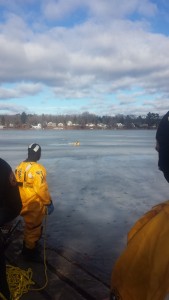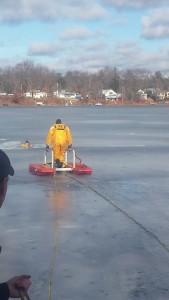
A rescuer is in the icy Hampton Ponds water during ice rescue training last week. (Photo by: Dan Desrochers)
WESTFIELD–No matter the conditions, whether it is sleet, snow, rain or ice, the Westfield Fire Department is prepared for any hazard.
The department trained several personnel this past week on the Hampton Ponds in Westfield, for ice rescue training. The training is done yearly and provides firefighters with the rare experience of rescuing someone who has fallen through ice and into a body of water and utilized several unique devices, which could one day save a life.
“We want to be ready for all emergencies,” Westfield Fire Deputy Chief Eric Bishop, said. “We continuously train to be ready.”
The training, although at all times safe due to a series of measures to ensure personnel well-being, puts personnel in a ice-water drowning simulation by having one of the rescuers out in the icy water. However, all personnel involved in the training on the ice, from the rescuers to the victim, are protected with a watertight and insulated suit called the “Ice Commander Suit.”
The suit, which is made by Mustang Survival, is a full-body suit that provides protection against cold and ice for long periods of time. In addition, the suit also has tethered ice picks on the arms for easy access in case there needs to be self-extraction, and also has inner buoyancy to prevent the rescuer from sinking.
In order to rescue the person in the water, a rescuer is provided with a modified buoyant sled to get to the person and to carry them to safety. The sled has two platforms, one on either side, that a rEscher can stand or kneel on, that are connected with heavy plastic piping. In the middle, there is a gap where a rescuer can utilize a paddle–which is provided–and reach a victim. Also on the sled are a series of straps that can be used to safely harness the victim onto the sled.

A rescuer goes out on the ice rescue sled to help a victim during an ice rescue training last week. (Photo by: Dan Desrochers)
Once the victim is harnessed in, usually by one rescuer, the sled is then pulled in by several other rescuers with ropes tethered to the sled.
“They go out to retrieve the victim and the personnel on shore pull them in, but we will always have someone else ready just in case,” Bishop said.
And if the victim is out in deeper water, or is too far away from the shore to be safely rescued with the sled, then the department will utilize its hovercraft to get to the person.
Once rescued, the victim is brought to a warm ambulance and is treated for hypothermia and any other possible injuries that may occur. This is a crucial step because even once a victim is out of the water, hypothermia can still set in due to wet or damp clothing and other factors. And the colder the water is, the quicker hypothermia can set in. If the water is 60 degrees F, hypothermia can kill its victim within four hours; if the temperature of the water is under 40 degrees, it can kill in as soon as a half-hour.
Treatment for those suffering from hypothermia may include warm blankets, heat packs, passive heating measures and warm intravenous saline.

